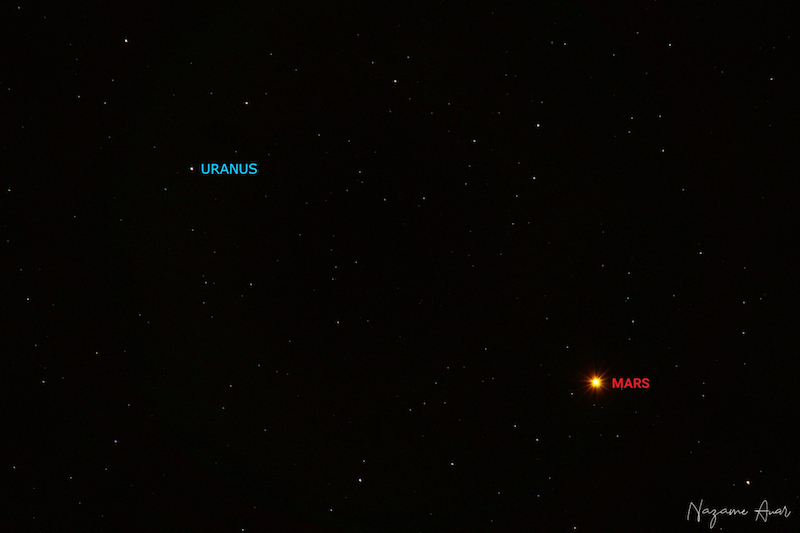The “parade of planets” observed this year from March to June has another interesting consequence: all its “participants”, moving along the celestial sphere, on one day or another find themselves in the sky not far from each other. A total of 18 such conjunctions are expected throughout the year. Among them was the extremely rare convergence of Venus with Neptune at a distance of 25 arcseconds, which took place on April 27. Unfortunately, it was impossible to observe it from the territory of Ukraine. More than half of the planetary conjunctions occurred in March and April, when Venus and Mercury took turns “visiting” Saturn, Mars, Neptune, Jupiter and Uranus. And now we have the opportunity to see the last event of this series — the conjunction of Mars with Uranus.

The minimum distance between the planets was 1°18′, which is almost three times the apparent diameter of the lunar disk. This means that they could be seen simultaneously in the field of view of a small telescope or binoculars. For three more days, Uranus and Mars will be located within 2° of each other, and if a cloudless sky eventually appears above us, we will still have time to see the last of the conjunctions involving the outer planets. You need to watch them closer to dawn, when they will rise high enough above the horizon.
Bright reddish Mars, the brilliance of which will be almost zero magnitude, is easy to detect over the eastern part of the horizon. To search for Uranus, you need a dark and clear sky: its brightness barely exceeds the limit of visibility with the naked eye. However, even small astronomical instruments will demonstrate it without problems, and when magnified more than 100 times, you can also see a small greenish disk of the lightest gas giant. A beautiful scattered star cluster will be located 12° east of both planets. Pleiades.
Interestingly, in absolute units, the brightness of Mars will exceed the brightness of Uranus by 170 times, despite the fact that the diameter of the first is 7.5 times smaller than the second. This is due to the fact that Mars is located 14 times closer to the Sun — at a distance of 1,394 AU, compared with 19.69 AU for Uranus — and receives 200 times more light from it per unit surface. Proximity to the Earth also plays a role: 1,126 AU (168.5 million km) separates us from the Red Planet, and 19.82 AU from the “green” one.
By the end of the year, three more planetary conjunctions are expected, but only Mercury and Venus will participate in them, and all of them will occur near the Sun, which will make their observations almost impossible. The last of them has a chance to be seen in our latitudes on the evening of December 29, 2022.
Follow us on Twitter to get the most interesting space news in time
https://twitter.com/ust_magazine
